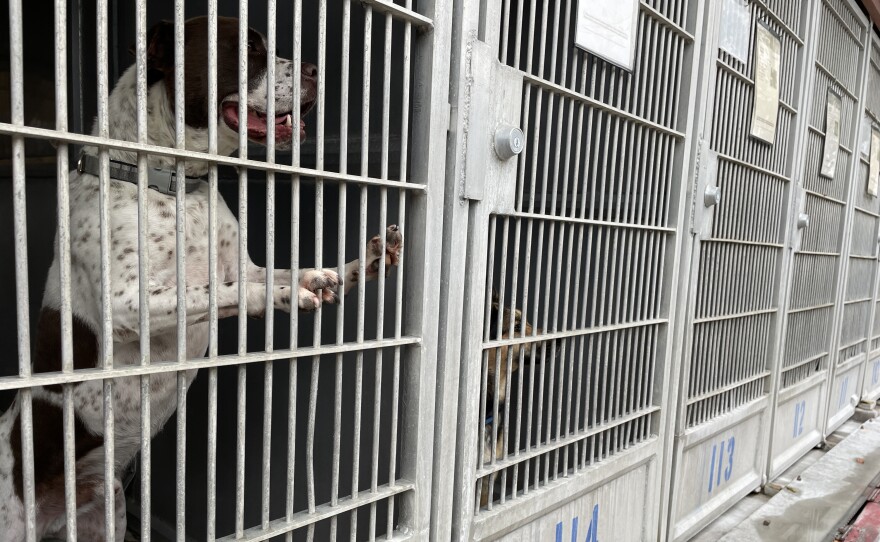Jeanne Miller didn’t want to say goodbye to Franklin, the four-year-old Great Pyrenees she adopted a few days earlier from a San Diego County-run animal shelter.
Franklin did exactly what Great Pyrenees are bred to do. The large, fluffy dog patrolled the fenceline at Miller’s Carlsbad home and kept predators from the family’s chicken coop.
“You could tell he had a good disposition,” Miller said last month, sitting on her back patio at sunset.
But Miller’s Great Dane, Buttercup, wasn’t so keen on Franklin. She growled and barked at the new dog. Miller sensed an untenable situation. Franklin had to go back to the shelter.
The San Diego County Department of Animal Services runs two animal shelters, one in Carlsbad and another in Bonita. The shelters take in thousands of dogs every year that have been abandoned, neglected or found wandering the streets.
Miller brought Franklin back to the Carlsbad shelter in late December. A staff member leashed Franklin and led him into a back room as a tearful Miller filled out the return form. “Good boy, very nice,” Miller said in the paperwork, which was obtained by KPBS. “Zero issues with food, seemed well trained.”
The front desk employee told Miller that her positive feedback would boost Franklin’s chances of finding another home. However, Miller’s kind words had no impact on the dog’s fate. At that moment, a shelter employee in the back was preparing an 11-milliliter injection of sodium pentobarbital, the chemical used by many shelters to euthanize dogs.

Franklin was likely euthanized while Miller was still standing at the front desk — possibly before her positive feedback was even entered into the shelter’s computer system, according to records obtained by KPBS and interviews with a former employee who worked that day.
Have a tip? 📨
The Investigations Team at KPBS holds powerful people and institutions accountable. But we can’t do it alone — we depend on tips from the public to point us in the right direction. There are two ways to contact the I-Team.
For general tips, you can send an email to investigations@kpbs.org.
If you need more security, you can send anonymous tips or share documents via our secure Signal account at 619-594-8177.
To learn more about how we use Signal and other privacy protections, click here.
It remains unclear why the shelter so hastily euthanized Franklin. A different adopter had previously returned him for resource guarding food and growling at a family member. He also tried to nip on a few occasions — a less serious type of bite, often playful or attention-seeking in nature.
But the one-page euthanasia record didn’t mention any of that. In fact, it noted that Buttercup was the reactive one in Miller’s home, not Franklin. Nonetheless, an employee labeled Franklin as unhealthy and untreatable due to a behavioral issue.
A monthslong KPBS investigation found euthanasia rates for dogs in the county’s shelters more than doubled from before the pandemic. Last fiscal year, the shelters made the decision to euthanize 426 dogs. That meant canines entering the shelter system had a more than 1-in-10 chance of being put down.
To justify these euthanasias, shelter staff and supervisors increasingly cite behavioral issues that are “untreatable.” In fact, the county claims it hasn’t euthanized a single dog with a “treatable” condition in the last decade.
But former employees and shelter volunteers claim dogs with mild behavioral problems are routinely and unnecessarily euthanized at the county’s two shelters. One former shelter employee laughed in disbelief at the shelter’s claim that it hasn’t euthanized a treatable dog 10 years.
“It’s just ridiculous,” they said. “It can’t be zero.”
KPBS reviewed more than 200 pages of medical and behavioral evaluations for euthanized dogs dating back to late 2023 that had been flagged by concerned volunteers and former employees. The analysis identified canines that were euthanized for common behavioral issues, including: displaying fear and not being potty trained; growling when someone tried to touch their bowl or toy; separation anxiety; lunging or growling when introduced to an unfamiliar dog.
Each of these conditions was deemed “untreatable.”
“There's definitely ways to help these dogs and make them have a long life,” said Kristina Smith, a former animal care attendant at the Carlsbad shelter who resigned last year. “I feel like the county takes the easy way out, saying, ‘Oh, we'll just euthanize and it's not our problem.’”
“I feel like the county takes the easy way out, saying, ‘Oh, we'll just euthanize and it's not our problem.’”
Smith was one of 11 former shelter employees and volunteers KPBS interviewed for this story. The rest requested anonymity due to fear of negative professional consequences for speaking out.
County spokesperson Chuck Westerheide declined KPBS’ request to interview Department of Animal Services director Vaughn Maurice.
“Euthanasia decisions in animal shelters are among the most difficult and emotionally challenging responsibilities in the field of animal welfare,” Westerheide wrote in an email. “These decisions are never made lightly. They involve careful assessment by veterinary staff with behavioral training and management teams.”
Westerheide said the department “is committed to protecting the health, safety and welfare of people and animals” and that the shelters “do not euthanize due to space limitations or length of (stay).”
Shelter statistics show the vast majority of dogs that enter the county’s system wind up leaving alive. The county touts the thousands of dogs that are adopted out to new homes, reunited with their owners or placed with rescue organizations every year.
But behind the scenes, the department is beset by poor record-keeping and critical communication breakdowns when it comes to euthanasias, the KPBS investigation found. County records also show the department had a staff turnover rate of 68% last year, leaving key positions vacant.
“I left because I lost faith in them,” said one longtime employee who recently departed.
Euthanasia rates spike
For years, the Department of Animal Services provided shelter services to cities throughout the county, taking in over 10,000 dogs every year.
In 2018, amid mounting criticism of its operations, the county handed off most shelter responsibilities to the San Diego Humane Society. The department’s two remaining shelters serve the county’s unincorporated areas and take in several thousand dogs annually.
After reducing its scope, the department’s dog euthanasia rate dropped, according to a KPBS analysis of county shelter statistics. In fiscal year 2016-2017, the county euthanized about 7% of the dogs it took in. Three years later, the rate decreased to less than 5%.
The euthanasia rate continued to dip during the pandemic — like it did in many shelters across the country — as the county took in fewer dogs.
But since 2022, the euthanasia rate has spiked. Last fiscal year, the county euthanized roughly 12% of the dogs that entered its shelter system. In the first 9 months of the current fiscal year, the euthanasia rate was at roughly 10%.
(KPBS’ analysis examined euthanasias initiated by the shelter and excluded instances when an owner requested their dog be put down.)
By contrast, the euthanasia rate at the San Diego Humane Society — which takes in more than 10,000 dogs every year — has hovered between 5% and 7% since 2018.
“Nationwide we are seeing increases in euthanasia in dogs,” said Dr. Lena DeTar, associate clinical professor at Cornell University's College of Veterinary Medicine. “It is a little bit more concerning to see the trend at the county.”
She noted that a euthanasia rate between 10% and 12% is not “crazy high” compared to other government-run shelters around the country, especially ones that are constantly struggling with space and resources. But the increase at the county raises concerns.
In recent years, the majority of dogs euthanized by the county were put down for behavioral reasons, as opposed to medical conditions.
“Some of the increase in serious and unsafe behavioral issues may be linked to the lack of training and socialization as pets were adopted in larger numbers during COVID, only to be relinquished again,” Westerheide said in an email.
‘Just semantics’
Decades ago, California passed a law stating “no treatable animal should be euthanized” by shelters or rescue organizations. The law encouraged — but did not require — this standard.
On July 1, 2015, San Diego County went a step further. The Department of Animal Services declared its shelters would no longer euthanize any animals with “treatable” medical or behavioral conditions. “Treatable,” according to the department’s policy manual, means a condition that can be addressed with “reasonable treatment or intervention efforts.”
For years before announcing this goal, the county had euthanized hundreds — or sometimes thousands — of treatable dogs annually.
And then there was an immediate drop. From the exact day the county made its announcement, the county claims its shelters have not euthanized a single treatable dog.

Observers are doubtful.
“It’s just semantics,” said DeTar after reviewing the county’s euthanasia statistics and paperwork on several dogs who were recently put down. “Shelters do this all the time.”
That’s because terms like “treatable” and “untreatable,” according to DeTar, are vague.
“You can change these categories whenever you want to,” she said. “You can decide that an animal is treatable because it's something that your shelter can treat, or it's untreatable because it's something your shelter doesn't have the resources to treat.”
In an email, Westerheide wrote the department follows the definitions laid out in the Asilomar Accords, a set of standards followed by many shelters around the country. He would not say whether the department stands by its claim of euthanizing zero treatable dogs in the last decade.
Lives cut short
The volunteers and former employees KPBS interviewed said they were deeply troubled by many decisions to euthanize dogs.
Take, for instance, Lily Jean, a 1.5-year-old shepherd mix. Videos provided to KPBS show Lily Jean on a walk, appearing curious and alert. Her tail is often wagging and she’s fond of ear scratches.
KPBS requested all medical, behavioral, handling and euthanasia paperwork for Lily Jean. A few weeks after entering the Carlsbad shelter last May, she was adopted. But the person returned her after two days.
“She needs a bigger space,” the adoption return paperwork states. “She is a great dog, but is also scared of a lot of things. She's scared to use the bathroom outside.”
The following week, a shelter supervisor took Lily Jean on a walk. A behavior memo notes she was “eager to leave (the) kennel” and “frantic while leashing.” Lily Jean appeared nervous of her surroundings and whined while walking, the memo continued, and she remained vocal when returned to the kennel.

The next morning, Lily Jean was euthanized. It wasn’t until two days later, according to timestamps on the paperwork, that shelter staff backfilled a reason.
“Dog meets the criteria for Fearful canine U/U,” the memo states, using the abbreviation for unhealthy and untreatable. “Quality of life is considered very poor.”
DeTar was perplexed after reviewing Lily Jean’s paperwork.
“Nothing in that behavior memo tells me why you would make a behavioral euthanasia decision on this dog,” she said. “There are no red flags. The fact that a dog is not potty trained — we see that all the time in shelters.”
Unless Lily Jean had other issues that were not documented, DeTar added, the evidence does not support that her quality of life was “very poor.”
In an email, Westerheide defended Lily Jean’s euthanasia.
“Staff felt in this case that the dog was experiencing an unreasonable amount of fear, resulting in suffering,” Westerheide wrote. “(Lily Jean was) unlikely to be successful in a home.”
Westerheide wrote the adopter described Lily Jean as “extremely” fearful. This claim is not supported by Lily Jean’s paperwork provided by the county.
KPBS also requested all medical and behavioral documents for a 2-year-old Siberian husky mix named Tanner. He was in the shelter for nearly all of last year. Staff and volunteers praised Tanner as “happy” and “curious” in behavior memos. He was friendly with people, including children, and played well with other dogs.
“He was just happy-go-lucky,” said Smith, the former shelter employee. After resigning last April, she stayed on as a volunteer with the shelter. She left very positive feedback for Tanner after taking him out for a walk in the community.

Tanner’s paperwork did note a few minor incidents. He growled when a handler tried to take a ball from his mouth one morning. Another time, a volunteer on a hot day stuck their hand in Tanner’s bowl to pat him down with water. Tanner again growled, but quickly became his “normal self,” the volunteer noted.
One day last November, according to another memo, a staff member walked by Tanner’s kennel. The dog moved toward the back and growled. The staff member was not able to coax him forward.
Fifteen minutes after logging this memo, according to timestamps on Tanner’s paperwork, the employee labeled Tanner “unhealthy” and “untreatable” for resource guarding and requested he be euthanized. The memo cited criteria — such as biting, snapping and snarling around coveted items — that did not reflect Tanner’s behavior described in previous memos.
“I know the wrong call was made for him,” Smith said.
In an email, Westerheide defended the shelter’s euthanasia decision.
“The dog wasn’t eligible to be fostered or adopted out for safety reasons,” he wrote. “This pet exhibited unpredictable aggression toward people and resource guarding.”
Westerheide did not elaborate when KPBS asked for examples of Tanner’s “unpredictable” aggression.
KPBS also reviewed comprehensive records for a number of other euthanized dogs that raised concerns for former employees and volunteers. One was put down for separation anxiety, and a few others for growling or lunging at unfamiliar dogs.
Communication problems
KPBS’ investigation found communication lapses within the Department of Animal Services when it came to euthanasia decisions.
Three of the dogs mentioned in this story — Lily Jean, Tanner and Franklin — could have been spared from euthanasia if the department followed its own protocols and shelter best practices.
On the afternoon before Lily Jean was euthanized, for example, a shelter volunteer sent an email to Department of Animal Services supervisors, according to records obtained by KPBS. The volunteer wanted to foster Lily Jean and submitted the necessary paperwork to take her out of the shelter. The recipients included the supervisor who ultimately decided Lily Jean’s fate.
But the volunteer didn’t hear back that day. Instead, Lily Jean was put down the next morning. A shelter employee notified the volunteer a few hours later that Lily Jean had been euthanized.
The volunteer expressed frustration and asked for an explanation. She never got a clear answer.
In an email, Westerheide maintained that Lily Jean was “unsuitable for placement as a pet” but did not specifically address why the foster request was ignored.

Tanner was euthanized under similar circumstances. Smith said she offered to be a backstop if the Siberian husky mix was ever considered for euthanasia.
“I told them, specifically, if he ever gets put on the (euthanasia) list to please contact me,” she told KPBS. “I will get him.”
One day, Smith noticed Tanner was taken off of the county website. Fearing the worst, she said she reached out to the shelter offering to foster Tanner.
But the shelter put him down the next day, Smith said.
“When I found out he was euthanized, the only message I ever got back for why was like, ‘Oh these things happen,’” she said.
In an email, Westerheide claimed state and federal laws prevent the department from allowing employees to foster animals.
The department’s own policy manual, however, explicitly states that “employees and volunteers may foster animals.” Besides, Smith was volunteering with the shelter at the time and had already resigned as an employee.
When presented with this information, Westerheide revised his response: “Given concerns about his dangerous behavior, Tanner was not eligible for fostering.”
In the case of Franklin, the Great Pyrenees, the department neglected its own euthanasia procedures. According to an internal department presentation titled “Introduction to Euthanasia,” shelter staff are supposed to verify an animal has no “holds” before moving forward. A hold is often placed on stray or returned animals for at least several days to ensure they aren’t hastily put down.

Franklin had a hold date of Jan. 3, 2025, according to his file. But he was euthanized on Dec. 30, 2024.
The hold would have saved him. Miller, the woman who adopted and returned Franklin, came back to the shelter a couple days later.
“We went back and we go, ‘That's it, let's make it work,” she said. “I felt really guilty and that's why we went back.”
An employee told her Franklin was “gone.” Miller assumed Franklin had been adopted.
Westerheide did not explain why Franklin was euthanized before his hold date. In an email, he wrote the dog “could not be safely adopted” and claimed Franklin’s history included “biting.”
When KPBS asked Westerheide to provide examples of Franklin’s bite history, he revised his response: “The (previous adopter) reported two separate incidents involving attempted nipping and growling.”
Questions surround committee
The county claims nearly every euthanasia case is “carefully reviewed” by an internal committee of department staff and medical professionals at a weekly meeting, according to a fact sheet provided by Westerheide.
“The team discusses the facts and circumstances before reaching a consensus on the most appropriate and compassionate decision for the animal and the community,” the factsheet states.
In an email, Westerheide said the committee plays a “vital role” in the decision-making process for animals. Yet, there’s little available information about the committee and its actions.
In response to a request from KPBS, Westerheide said the committee does not maintain records such as meeting notes or minutes.
DeTar flagged the county’s lack of detailed recordkeeping as a concern.
“Without a record, it's hard to say what exactly happened and why decisions were made,” the Cornell University professor said. “It makes it really challenging for this shelter if they're going to try to defend themselves.”
Westerheide said the committee’s euthanasia decisions are reflected in a dog’s paperwork. KPBS found no mention of the committee in its review of dogs’ medical, behavioral and euthanasia notes for this story.
KPBS obtained emails that showed shelter staff requesting euthanasia for specific dogs and receiving approval within hours or even minutes from supervisors. It’s unclear how the committee could have weighed in on these decisions under such a tight turnaround.
Westerheide said in an email that committee review “is not always appropriate for each animal in our care,” such as when they arrive with a serious medical or behavioral condition.
Staff turnover, key vacancies
The county claims it does not euthanize animals to free up space or reduce overcrowding. According to interviews with former staff and volunteers, this appears to be true — physical shelter capacity is not the primary issue.
Instead, former employees point to short staffing, high turnover rates, stressful kennel conditions and a lack of resources to rehabilitate dogs with mild or moderate behavior issues.
The department of Animal Services had a 68% staff turnover rate in 2024. The department’s goal, according to the county budget, is to reduce that rate to 35%.
The shelter has struggled to retain animal care attendants, who work with animals in the shelters and are often tasked with performing euthanasias. For some, the mental health toll was too much.
“In just the four months that I worked there, my mental status (had) dramatically decreased,” said Smith. “I felt like I wasn't myself.”
The vacancies include key leadership positions. The department’s chief veterinarian role remained vacant for at least the last two years. The department filled the position in June.
A constant cycle of losing employees and scrambling to fill vacancies has hampered the day-to-day functions at the county’s two animal shelters, according to interviews with former employees. They said some dogs are left in kennels for multiple days on end without walks or yard time.
On a good week, according to Smith, staff would get dogs out of their kennels three or four times. But not for very long.
“Even the walks would be fairly short because we (were) short staffed,” she said. “We were told, like, no more than like 10, 15 minutes.”

Smith and other former employees noted that volunteers also helped walk dogs, but it still wasn’t enough.
Experts say getting dogs outside for activity, enrichment, training and socializing is essential for their health and adoptability. Keeping dogs inside small kennels for extended periods can exacerbate existing behavioral problems or create new ones.
The county’s shelters do not employ any animal behaviorists, according to a review of its personnel records. (By comparison, the San Diego Humane Society has an entire behavior center to work with dogs.)
Instead, lower-level shelter staff are responsible for providing behavioral training and rehabilitation, according to shelter documents and employees who spoke to KPBS. Westerheide wrote in an email that these staff “receive hands-on training with a supervisor regarding animal handling, enrichment, and behavioral assessment.”
Smith trained and rehabilitated aggressive dogs at a previous job. She said she tried to bring that expertise to the shelters with no luck.
“I was told to go do things like laundry and dishes, which in my mind were honestly not a priority,” said Smith. “I feel like I got a lot of backlash for trying … I was told we don't have the time, we don't have the resources.”
Smith said sometimes multiple shelter staffers would tell higher-ups that a dog shouldn’t be euthanized because it could be rehabilitated. But the euthanasias happened anyway.
“I feel like we were lying to the public a lot,” she said. “Because on our website we state we (only euthanize) when it's medically necessary, when it's not treatable.”
“I feel like we were lying to the public a lot because on our website we state we [only euthanize] when it's medically necessary, when it's not treatable.”
Miller said she only learned that the county euthanized Franklin, the Great Pyrenees, when KPBS contacted her for this story.
“They're deceiving,” she said.
Before returning Franklin to the shelter, Miller took him for a walk along the beach. She stopped at a Jack in the Box and ordered him two burgers — just the bun and patty — as a special treat before saying goodbye.
“It was pulling at me like, ‘Don't take him,’” Miller recalled. But she relented. “‘No, you’ve got to take him back so he has a chance to get a home.’”
She shook her head thinking back on that day.
“He didn't deserve what happened to him,” she said.









